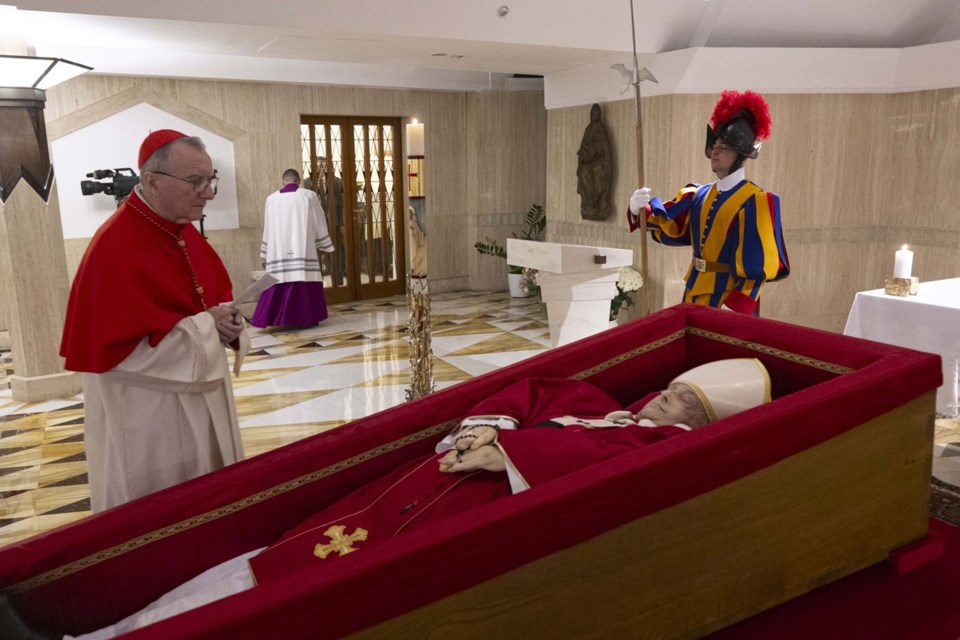VATICAN CITY (AP) — Pope Francis died on Easter Monday at the age of 88. Here are the key things to know about the death of the Argentine pontiff, history's first from Latin America, who presided over the Catholic Church for more than 12 years.
The timing and cause of Pope Francis’ death
Francis died Monday morning at the Domus Santa Marta hotel where he lived at the Vatican. His death came almost a month after he returned to the Vatican after being hospitalized for double pneumonia. The Vatican said that Francis suffered a stroke that led to a coma and caused his heart to fail.
On Tuesday the Vatican released its first images showing him in a wooden casket, in red vestments and his bishop’s miter, with the Vatican secretary of state praying over him in the chapel of the Domus Santa Marta. It also announced that the funeral will be held on Saturday at 10 a.m. in St. Peter's Square.
In his will, Francis asked to be buried in a simple underground tomb at St. Mary Major Basilica, home to Francis’ favorite icon of the Virgin Mary, to whom he was particularly devoted.
A final farewell on Easter Sunday
Francis made his final public appearance on Easter Sunday, a day before his death. He appeared very frail, and delegated the celebration of the Easter Mass to a cardinal. But though his voice was weak, he blessed a crowd of faithful from the loggia of St. Peter's Basilica.
Francis also made a surprise ride in the square in his popemobile, drawing wild cheers and applause.
Beforehand, he met briefly with U.S. Vice President JD Vance, who later said that Francis was “obviously very ill.”
Reactions and global mourning
Catholics worldwide mourned him from his native Argentina to the Philippines and across Rome as messages of tribute poured in from across the world.
Catholic and non-Catholic leaders alike honored a spiritual leader who was a voice for the marginalized and the weak, for migrants and LGBTQ+ people, and for environmental protection.
Representatives of other religions and other Christian denominations also praised him for seeking dialogue.
The pope's recent illness
Francis, who suffered from chronic lung disease and had part of one lung removed as a young man, was admitted to Gemelli hospital in Rome on Feb. 14, 2025, for a respiratory crisis that developed into double pneumonia. He spent 38 days there, the longest hospitalization of his papacy.
For the faithful, those were weeks of fear that his illness could be fatal or lead to another papal resignation like that of Pope Benedict XVI, a surprise move that led to the election of Francis in March 2013.
The pontiff's return to the Vatican on March 23 brought relief to many.
Mourning, funeral and then a conclave
Francis' death set off the process of allowing the faithful to pay their final respects, first for Vatican officials in the Santa Marta chapel and then in St. Peter’s for the general public.
A precise sequence of events will include the confirmation of death in the pontiff’s home, the transfer of the coffin to St. Peter’s Basilica for public viewing on Wednesday, and Saturday's funeral Mass and burial.
After the funeral, there are nine days of official mourning, known as the “novendiali.”
During this period, cardinals arrive in Rome to participate in a conclave to elect the next pope.
To give everyone time to assemble, the conclave must begin 15-20 days after the “sede vacante” — a Latin term meaning the seat is vacant — is declared, although it can start sooner if the cardinals agree.
The cardinals will vote in secret sessions, and the ballots will be burned in a special stove after each session.
Black smoke will indicate that no pope has been elected, while white smoke will indicate that the cardinals have chosen the next head of the Catholic Church.
Pope's record on Ukraine
Francis tried to maintain the Vatican’s traditional diplomatic neutrality when it came to Ukraine, and that led to criticism for what some called an unclear position on Russia’s invasion of its neighbor.
He at times expressed apparent sympathy with Russia’s rationale for invading Ukraine — like when he said NATO was “barking at Russia’s door” with its eastward enlargement. And last year he called on Ukraine to show the “courage” to negotiate peace.
Russian President Vladimir Putin in a condolence message praised Francis as a “consistent defender of the high values of humanism and justice.”
Ukraine's President Volodymyr Zelenskyy said his country was grieving and recalled how the pope often prayed for peace in Ukraine.
Legacy on clergy sex abuse
Francis also had critics who argued that he failed to bring justice to victims of clergy sex abuse or to bring the needed reforms to the church.
“In this realm, where Francis had supreme power, he refused to make the necessary changes. This choice is having devastating consequences for the Church’s most powerless members. It will forever tarnish the legacy of this remarkable man,” said Anne Barrett Doyle, co-director of BishopAccountability.org, a United States-based watchdog.
The Women’s Ordination Conference also lamented Francis’ unwillingness to push for the ordination of women. “This made him a complicated, frustrating and sometimes heart-breaking figure for many women," it said.
Vanessa Gera And Nicole Winfield, The Associated Press



